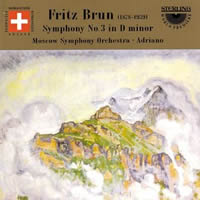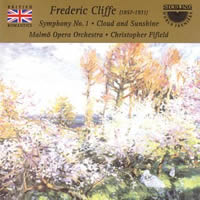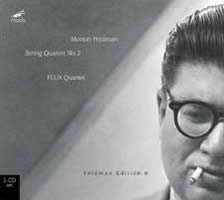The Forgotten, the Unfamiliar and the Unknowable
|
Grant Chu Covell [January 2005.]
Fritz BRUN: Symphony No. 3 in D minor (1919). Moscow Symphony Orchestra, Adriano (cond.). Sterling CDS-1059-2 (http://www.sterlingcd.com/). Frederic CLIFFE: Symphony No. 1 in C Minor (1889), Orchestral Picture: Cloud and Sunshine (1890). Malmö Opera Orchestra, Christopher Fifield (cond.). Sterling CDS-1055-2 (http://www.sterlingcd.com/). Sterling, a champion of the forgotten and unfamiliar, remains on target with these two releases. Swiss conductor and composer Fritz Brun (1878-1959) flourished in all forms. His third of ten symphonies ham-fistedly overlays Beethoven’s boldness (possibly it’s the resolute D minor) with Martinů-like twittering. The peculiar three-movement opus implies that Brun’s podium responsibilities checked his creativity. The opening minutes include an atonal flute / bassoon duet, and from this I expected a dynamic work rich with contrasts instead of an hour-long sequence of tentative episodes. The Moscow Symphony Orchestra strains at Brun’s engaging filigree, and the venue’s fuzzy echo doesn’t help the Muscovites’ imperfect intonation. Nevertheless, I’d keep an eye out for a different team tackling a later Brun symphony. Frederic Cliffe (1857-1931), an accomplished accompanist and piano professor, wrote only two symphonies. Conservatory politics and Elgar’s ascendancy overshadowed this Brit’s career. Cliffe’s First is fresh, with the confidence and vigor of firsts by Rott, Nielsen, Ives, and yes, Elgar. (Such comparisons throw Mahler’s First into a tepid light.) The initial measure’s bravado very nearly overpowers every other statement. Continental masters Dvorak and Brahms are not far away. Blended horn and trombone passages suggest Bruckner, whose Seventh Cliffe may have heard. An emotional Ballade recalls the extra movement in Schumann’s Rhenish. Dancing figures in the Scherzo, Finale and a rambling impressionistic tone poem Cloud and Sunshine mimic sprightly Mendelssohn. The recording’s venue contributes wide reverb, which adds extra stomp to brass but thins the upper strings. The Malmö Opera Orchestra under Christopher Fifield has a good time with it all.
Paul HINDEMITH: Kammermusik No. 2, Op. 36, No. 1 (1924); Concert Music for Solo Viola and Large Chamber Orchestra, Op. 48 (1930); Concerto for Piano and Orchestra (1945). Lee Luvisi (piano), Raphael Hillyer (viola), The Louisville Orchestra, Jorge Mester, Lawrence Leighton Smith (conds.). First Edition Music FECD-0022 (http://www.firsteditionmusic.com/). Hindemith totters in an elusive orbit. How many 20th-century principals are well-respected yet rarely heard? Cpo’s relatively recent multi-volume orchestral sets attempt exacting performances which strike me as exciting as actuary tables. These 1968, ’69 and ’87 Louisville tapings, with their dated dynamic range and minimal bass response, actually personalize the composer. More importantly, the Kentuckians play as if the admired academician were just another displaced European. The Louisville Orchestra clothes the Kammermusik and Viola Concerto (with its perversely long-winded title) in prewar neo-classical colors. Were it not for the purposeless passagework, the fast movements in either could pass for Stravinsky. The 1945 Piano Concerto with its quaint variation-finale finds collegiality with Bartók and Ravel. Luvisi prefers rubato instead of staccato hammering, suggesting that Hindemith could carve enchanting melodies. Hillyer is warm and expressive, his spirited sawing captured with bus-depot-sized reverb. First Edition Music reissues uncharacteristically humane Hindemith, definitely worthy of attention. Morton FELDMAN: String Quartet No. 2 (1983). FLUX Quartet. mode 112 (http://www.mode.com/). This Feldmaniac tried but failed. I don’t have the endurance for a recording of String Quartet No. 2. I attempted the quintuplet CD set, sampling several CDs per day for two weeks, and then later started and stopped the single DVD-A over a week. The FLUX Quartet’s performance seems to me faultless, and the music offers many attractive passages. I nevertheless had trouble comprehending this sprawling, six-hour seven-minute seven-second monster. I was perpetually distracted: e-mail, the telephone, eating, all of life’s vicissitudes. I know this isn’t meant to be easy. Feldman intentionally pushes performers and listeners to the limit. Even so, SQ2 borders on dehydration and kidney failure. My attention span is good and I understand Feldman’s scale. The 112-minute Triadic Memories (Louis Goldstein on Offseason Productions OP226) is more my pace. The 265-minute, multi-disc For Philip Guston (hat ART 61041/4) is an easier go. I’ve heard Goldstein confront Triadic Memories live, and that was a treat, but then again, I’ve also snoozed through Die Walküre at the Vienna Opera. Late in life Feldman was always thinking about his beloved Turkish carpets. As SQ2 progresses, you will perhaps notice how sunlight plays upon the mind’s rug. The string quartet’s homogeneity may be part of the attention problem. Feldman’s quartet writing is generally very quiet, rich with harmonics and ethereal gestures. There’s no Paganini-like passagework, nothing resembling filigree. The quartet sounds more like a muffled harmonica, and the FLUX folks exquisitely portray these reedy, smoky hues. SQ2 is calm like other large-scale late works, but bleaker. Many motives feature a slowly rocking semitone, like a moored boat gently bumping a dock. I routinely pictured Venetian gondolas, or better yet, Charon’s ferry waiting to cross the Styx. There was a day when the oscillating semitones ushered an altogether different kind of minimalism: One of Philip Glass’ rudimentary chord progressions ran around in my head after tackling a few SQ2 CDs. I also made connections with Nono’s Fragmente-Stille, An Diotima with its slow pace, awkward intervals, barely audible dynamic shifts and close-spaced harmonics. Feldman’s delicate answer / response passages likewise suggest Andriessen’s hocketing. This is not wallpaper. When you can concentrate, Feldman really does draw you in. You start to hear patterns, to make predictions based on something heard hours before, and marvel at the FLUXers’ control. Other reviewers have leaped out of their chairs (rolled out of their cots?) in praise of this and another recording (the Ives Ensemble on hat[now]ART 4-144). A comparison is beyond me. How many have really been drawn into Feldman’s heart of darkness? Others enumerate survival strategies, all of which suggest that one is not really expected to listen to all five CDs in one sitting. If so, what’s the point? Does one claim to have seen Mount Rushmore after glancing at a postcard? Who travels to South Dakota only to inspect Lincoln’s beard? Would you view Washington’s nose from the road or from the sculptor’s scaffold? I recall a movie projectionist’s anecdote. She showed a dry-as-dust, multi-reel film of one of Shakespeare’s history plays. No intermission. The credits finally arrived. However, the reels had been mishandled. One was still in the can. The house lights came on, the audience departed, with nobody having remarked the gap. I suspect that people will listen to a portion of this quartet or perhaps even the first CD twice and fail to notice that they missed anything. What would Feldman have made of that?
[More Grant Chu Covell]
[Previous Article:
Notebook from Turkey]
[Next Article:
Italian Vacation 2.]
|



